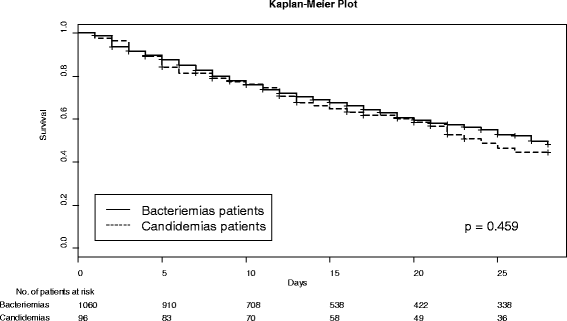Characteristics and risk factors for 28-day mortality of hospital acquired fungemias in ICUs: data from the EUROBACT study
- PMID: 26956367
- PMCID: PMC4784333
- DOI: 10.1186/s13054-016-1229-1
Characteristics and risk factors for 28-day mortality of hospital acquired fungemias in ICUs: data from the EUROBACT study
Abstract
Background: To characterize and identify prognostic factors for 28-day mortality among patients with hospital-acquired fungemia (HAF) in the Intensive Care Unit (ICU).
Methods: A sub-analysis of a prospective, multicenter non-representative cohort study conducted in 162 ICUs in 24 countries.
Results: Of the 1156 patients with hospital-acquired bloodstream infections (HA-BSI) included in the EUROBACT study, 96 patients had a HAF. Median time to its diagnosis was 20 days (IQR 10.5-30.5) and 9 days (IQR 3-15.5) after hospital and ICU admission, respectively. Median time to positivity of blood culture was longer in fungemia than in bacteremia (48.7 h vs. 38.1 h; p = 0.0004). Candida albicans was the most frequent fungus isolated (57.1%), followed by Candida glabrata (15.3%) and Candida parapsilosis (10.2%). No clear source of HAF was detected in 33.3% of the episodes and it was catheter-related in 21.9% of them. Compared to patients with bacteremia, HAF patients had a higher rate of septic shock (39.6% vs. 21.6%; p = 0.0003) and renal dysfunction (25% vs. 12.4%; p = 0.0023) on admission and a higher rate of renal failure (26% vs. 16.2%; p = 0.0273) at diagnosis. Adequate treatment started within 24 h after blood culture collection was less frequent in HAF patients (22.9% vs. 55.3%; p < 0.001). The 28-day all cause fatality was 40.6%. According to multivariate analysis, only liver failure (OR 14.35; 95% CI 1.17-175.6; p = 0.037), need for mechanical ventilation (OR 8.86; 95% CI 1.2-65.24; p = 0.032) and ICU admission for medical reason (OR 3.87; 95% CI 1.25-11.99; p = 0.020) were independent predictors of 28-day mortality in HAF patients.
Conclusions: Fungi are an important cause of hospital-acquired BSI in the ICU. Patients with HAF present more frequently with septic shock and renal dysfunction on ICU admission and have a higher rate of renal failure at diagnosis. HAF are associated with a significant 28-day mortality rate (40%), but delayed adequate antifungal therapy was not an independent risk factor for death. Liver failure, need for mechanical ventilation and ICU admission for medical reason were the only independent predictors of 28-day mortality.
Figures
References
-
- Leroy O, Gangneux JP, Montravers P, Mira JP, Gouin F, Sollet JP, et al. Epidemiology, management, and risk factors for death of invasive Candida infections in critical care: a multicenter, prospective, observational study in France (2005-2006) Crit Care Med. 2009;37:1612–1618. doi: 10.1097/CCM.0b013e31819efac0. - DOI - PubMed
Publication types
MeSH terms
Substances
LinkOut - more resources
Full Text Sources
Other Literature Sources



